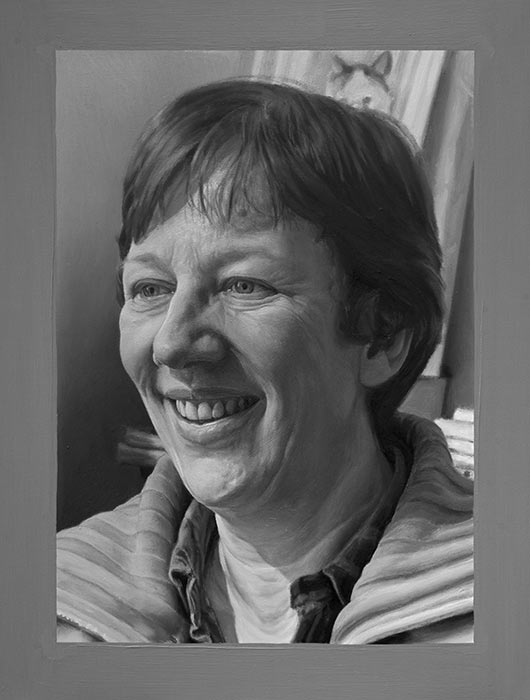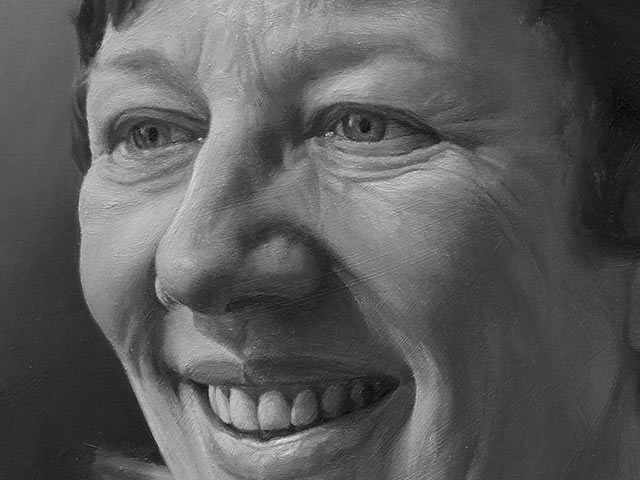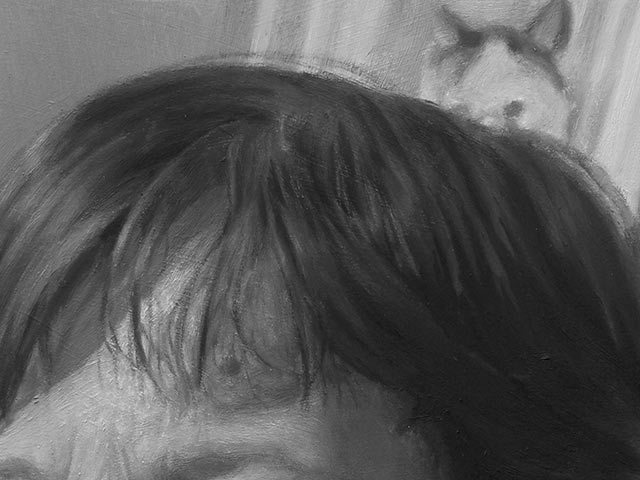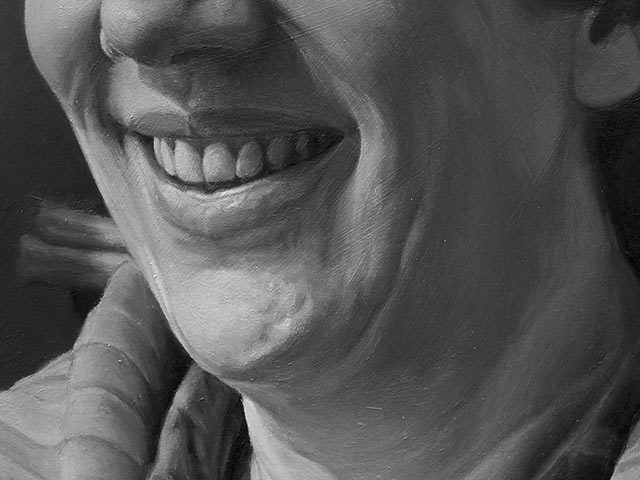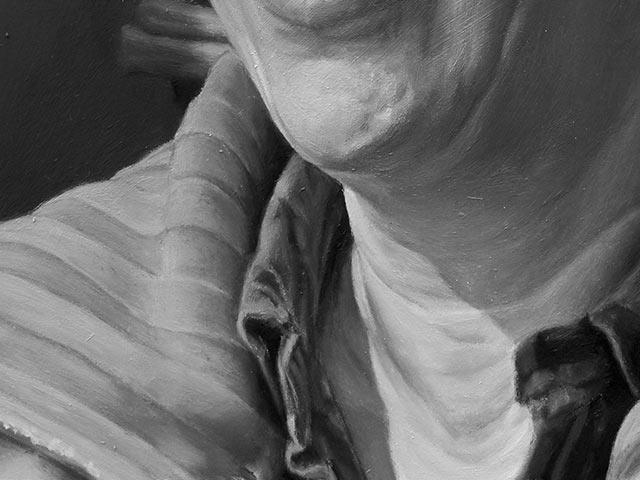29 cm (w) x 37 cm (h), oil paints on board.
Date produced: June - November 2019.
This portrait is of my wife, Marianne, who was a keen linguist, and a keen English Language Teacher. She died unexpectedly in May 2024. This was painted in 2019, when she was seemingly very healthy.
Marianne was a warm, remarkable and wonderful person, and woman. She was highly sensitive, highly intelligent, highly educated, highly qualified, with clear thinking skills, excellent social skills, had an excellent sense of justice, and was very aware of a wide range of news and current affairs. She was born in The Netherlands and over the years, had developed amazing skills in spoken and written Dutch, German, French, Italian, and English (as well as smaller subsets of Japanese, Korean, Vietnamese, Danish, Latin, Spanish, Portuguese, and some Slavic languages). If she heard a language being spoken, she usually had a very good idea of where in the world that language was likely to have come from.
The portrait started as a photograph of my wife in natural light. I positioned her in her room so that she was appropriately surrounded by some of her personal objects, she had interesting natural lighting from outside across her facial features, and she had a good fleeting smile on her face (an expression that is difficult to maintain for hours if being painted from directly). I wanted to have her head facing slightly away from my view, and not have her looking directly at me. The photograph was then used to become the reduced image of the ‘camera obscura’ (as proposed in “Tim’s Vermeer”, explained below).
I decided to paint a greyscale image to make the colour-mixing process less complicated (just need to use black paint and white paint). I found that the whole painting still took a considerable amount of time and skill and judgement to get it to a stage where it felt complete.
Painting Using A Mirror
This painting was done using a technique which allows a painter to directly compare the tones (and colours) of a subject image with those of a painting or drawing. A mirror is used for directly comparing tones, colours and the outlines of a subject image with those of a painting in progress.
I have been painting and drawing for more than 45 years, but have only come across this technique as a result of ‘fairly recently’ (in 2019) watching a documentary film made in 2013 titled, “Tim’s Vermeer”.
“Tim’s Vermeer” is a film about some of the ideas, skills and desires of one man, Tim Jenison, who is apparently not a painter, but who wanted to produce a similar painting to one that was produced by Jan Vermeer (born in 1632 and died in 1675 at the age of 43). Tim Jenison suspected that Vermeer used a ’mechanical process’ to help him paint images with photographic tonality, etc.
The central idea that Tim Jenison presents convincingly in the documentary, is that Vermeer probably used a mirror (a technology that was developed before his time) in combination with a ‘camera obscura’ (a darkened room with a lens that projects an image of a lit room) to help him paint images with ‘photographic’ tonality, colour and spatial accuracy. Tim Jenison proposed an ingenious method of using a small mirror to compare the tones and colours in a real scene (typically an indoor scene) from a small image projected by a ‘camera obscura’, with those made with paint on a painting. Photography was yet to be developed. After Vermeer’s death, it would take around another 150 years to develop a reasonable form of photography.
This painting was my first serious experiment into using the technique of painting using a mirror as described in that documentary.
One of the things I thought about early on is that it is not easy engineering a stand like the one in the documentary, with the single arm raised at approximately a 45 degree angle, and in particular, the adjustable head for tilting the mirror. I don’t have the advanced engineering skills or tools to manufacture a mirror head on a lockable ball joint (or something similar). I assumed that it is extremely important that the mirror position above the painting surface remained constant. I thought about other possible types of stands, that I could more easily manufacture, and control.
I ended up making a stand made from two aluminium square-tube uprights, with a long round aluminium tube suspended between the two supports. A mirror was glued to the centre of the round tube. The uprights had a series of holes drilled in them that would allow inserting the round tube at different heights. The round tube with glued mirror at its centre could be rotated gently to adjust the angle of the mirror. I added some grub screws to hold the round tube firmly in place.
I arranged my stand on a small table, to read a photograph projected on a computer monitor (which represented the image from a camera obscura). My thinking behind using a computer monitor is that I could easily invert an image and use that as my subject. I could also try different images quite easily, including those in greyscale, or full colour. I worked out that this system would work best if the image on the computer monitor was the same distance from the centre of the mirror as the distance of my painting surface from the centre of the mirror. That way, no matter how high my eye was from the centre of the mirror, when looking at both my painting and the subject, the distance from my eye to the painting surface would be the same as that from my eye to the image on my monitor.
I also worked out that this whole arrangement really relies on keeping all the elements completely fixed in relation to each other. That is, after getting all of the things accurately in place and angled appropriately on my table top, I screwed them all in place, so they would remain fixed in relation to all of the other components. I screwed the mirror stand legs to the table top. I screwed the base of the computer monitor to the table top. I also screwed my painting surface to the table top.
I set up the inverted black and white photograph on my computer monitor and checked the way it looked through the mirror. The mirror inverted the photograph back to its correct appearance, and I could move my head about over the mirror to see every part of the photograph. All good so far! I got ready to apply some paint.
When looking through the mirror, however, I realised that the dynamic range of the tones coming through from the monitor was much wider than the dynamic range of tones that are possible in paint under my ambient lighting. The whites on the monitor were much brighter than white paint looked on my painting surface under the lights I had set up. The blacks were similar in tone, but the monitor’s blacks were a little darker than my black paint looked.
I thought that this was a good reason for deciding to set up my computer monitor as my subject for this test painting. I could adjust the image and check the tones coming through by comparing them to strips of dried white and black paint resting on the painting surface. I adjusted the whole image for the changes in dynamic range, but then found another problem.
The monitor that I was using tends to darken parts of the image when you look at the vertical extremes (the top and the bottom sections of the inverted photograph) using the mirror. I needed to add further tonal adjustments to the photograph on the monitor using vertical gradient maps, to compensate for the changes in tone that the monitor caused. Once I was happy with the adjusted photograph I started the painting more seriously. | 